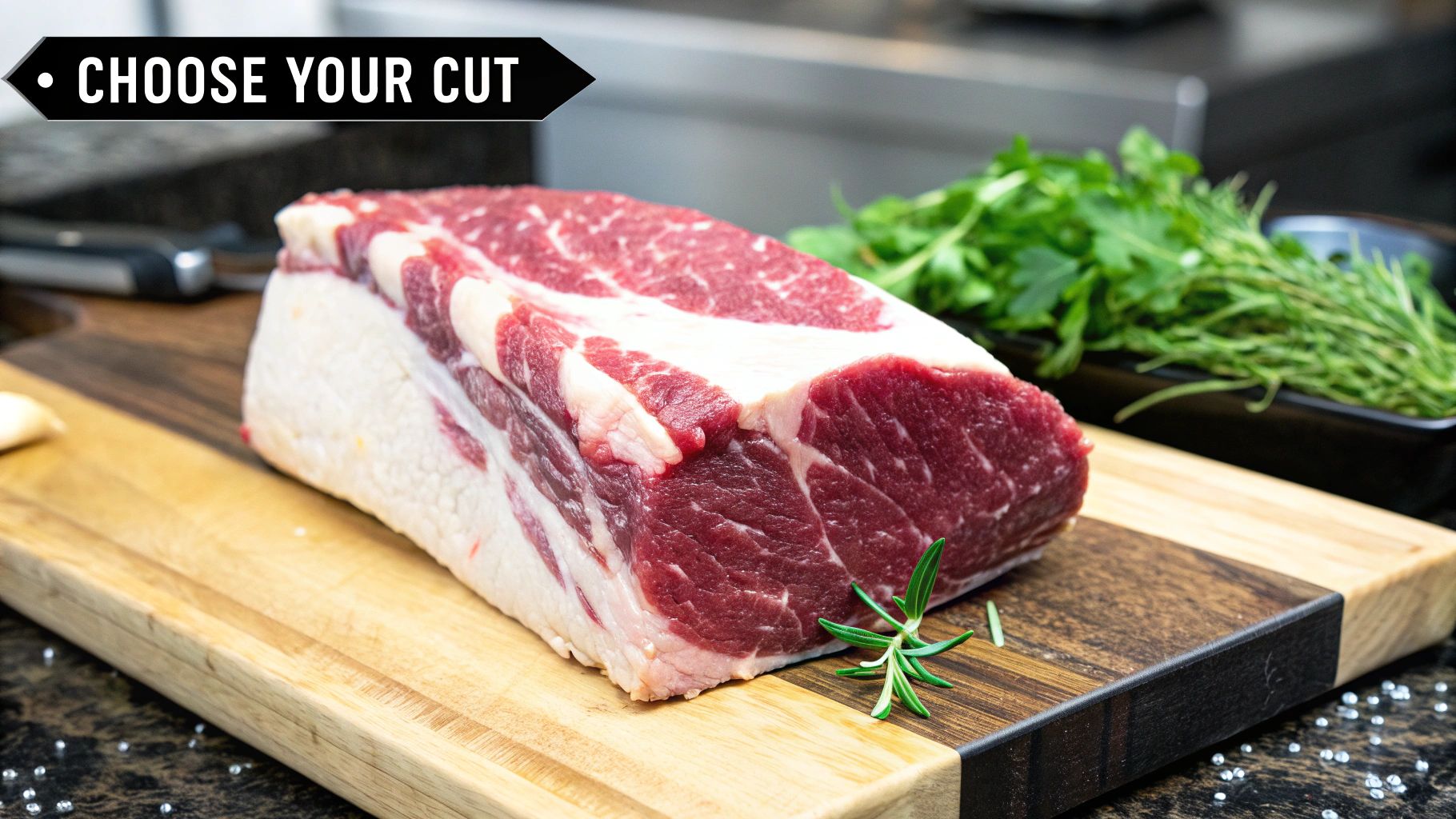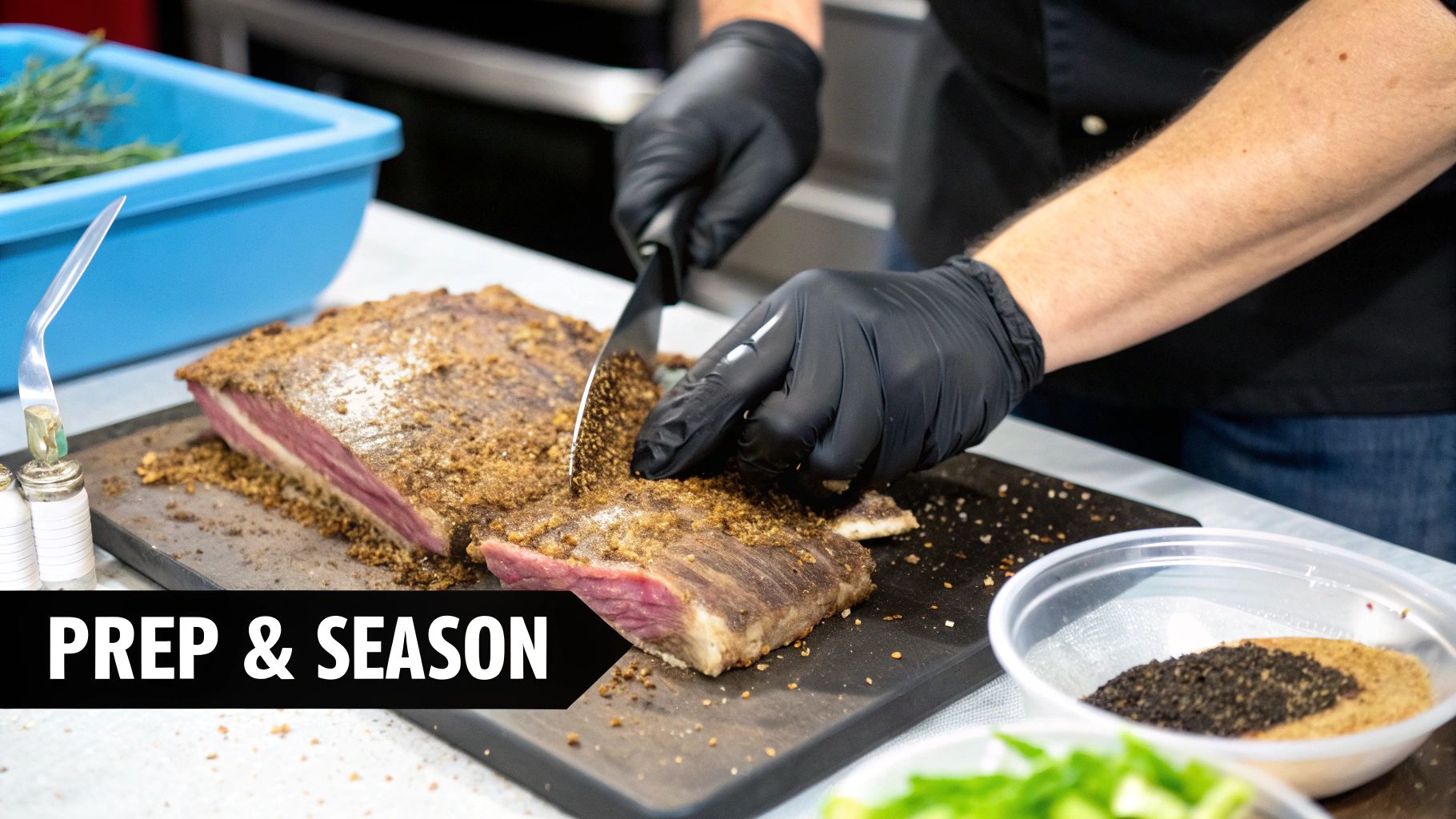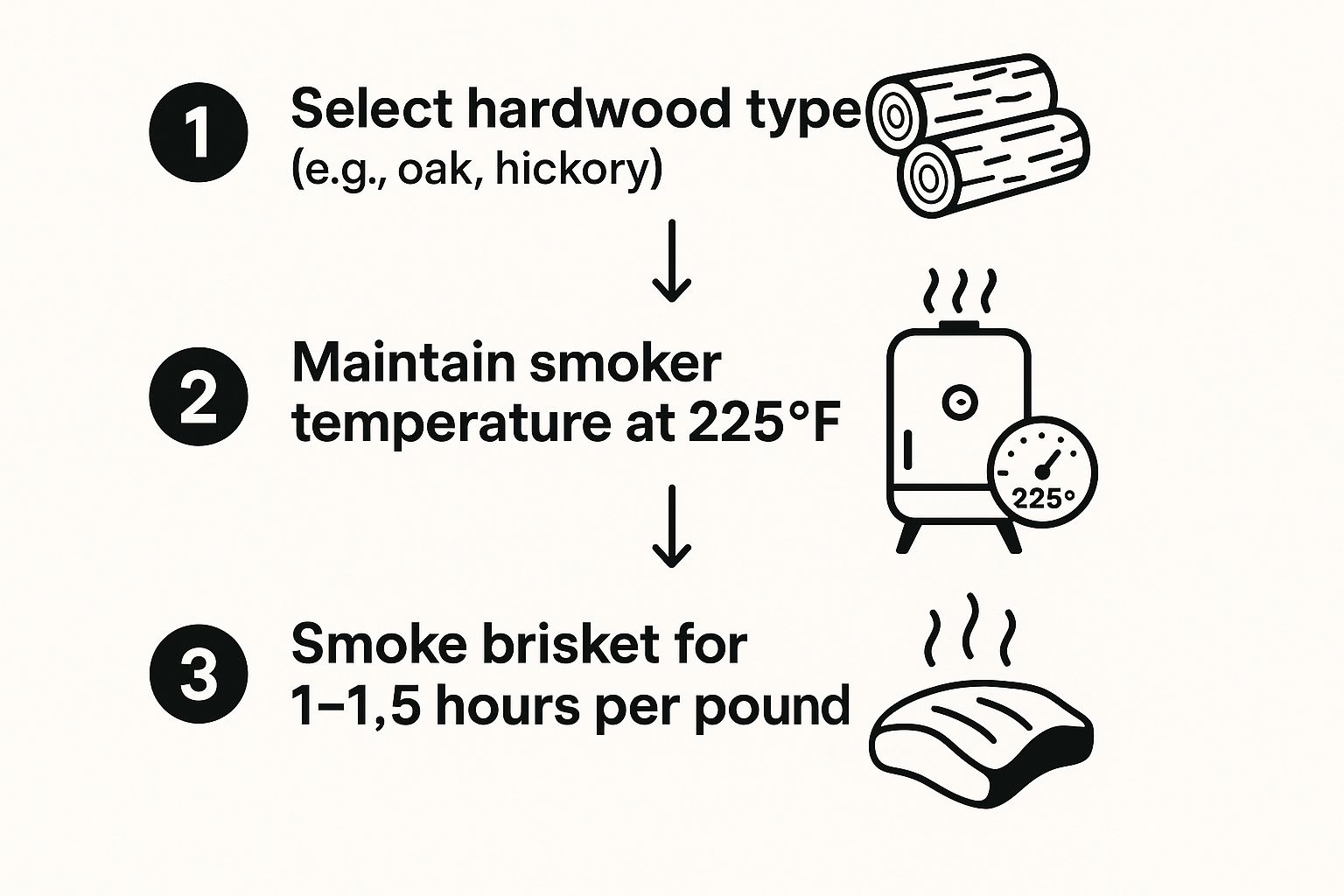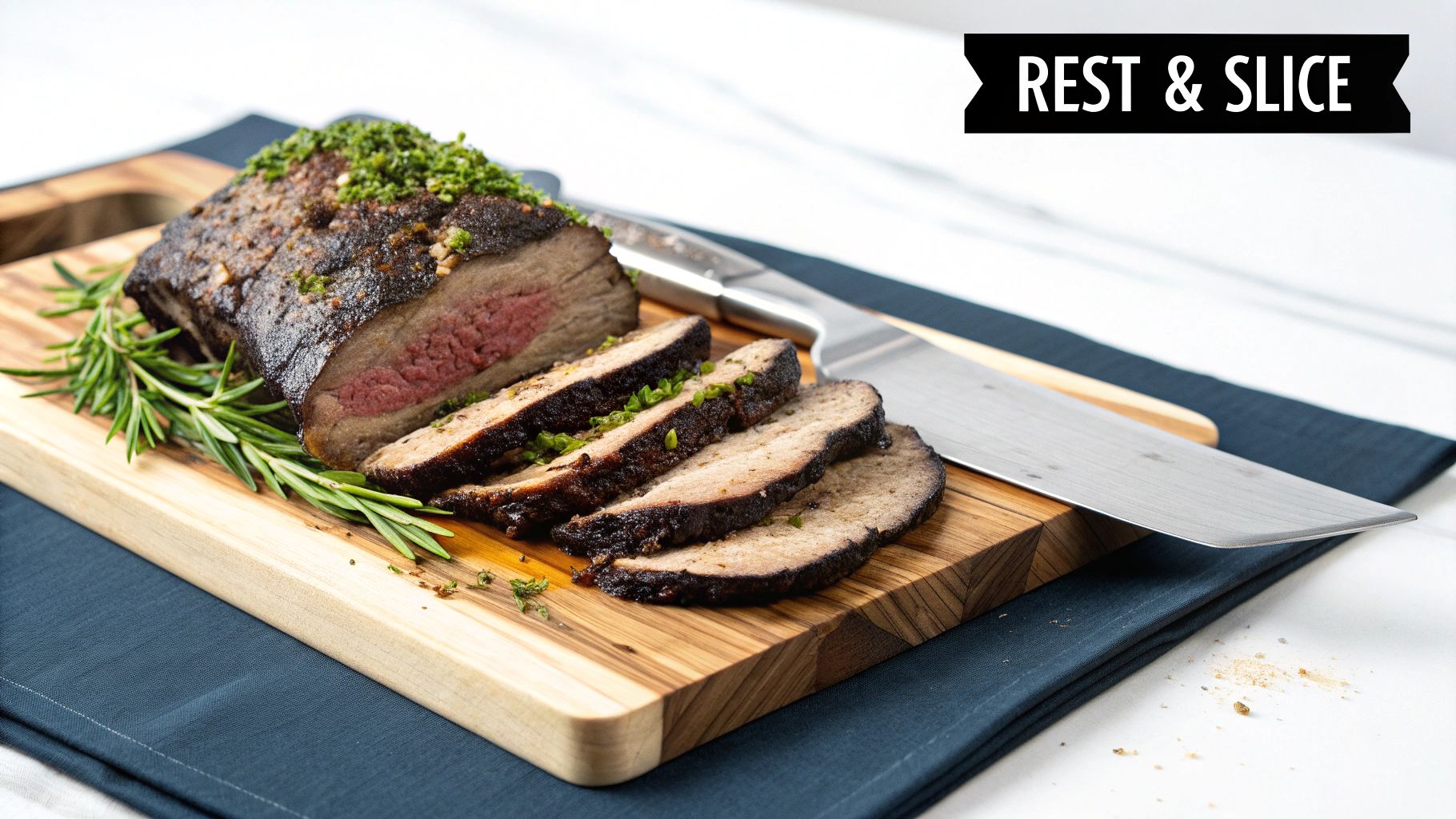How to Smoke Brisket: A UK Guide to Perfect BBQ
So, you want to learn how to smoke the perfect brisket? You've come to the right place. This is our definitive guide for anyone in the UK looking to master this legendary cut of beef.
Forget everything you think you know about complex BBQ. The secret to a mind-blowing brisket is actually pretty simple: low heat, slow cooking, and the right seasoning. Get those three things right, and you'll turn a tough, unwieldy piece of meat into something truly special – tender, juicy, and packed with authentic cultural flavours.
We're here to demystify the whole process, breaking it down into an achievable, step-by-step weekend project. No added crap, just pure flavour.
Your Journey to Perfect Smoked Brisket

This is more than just a recipe; it's a rite of passage for any BBQ enthusiast. We'll walk you through everything, from picking out a decent cut at a British butcher to carving that final, wobbly slice. No intimidating jargon or confusing steps here – just practical, real-world advice that works with the kit and ingredients you can actually get your hands on in the UK.
Let’s be honest, traditional roasts have long been the star of the show over here. But things are changing. American-style BBQ is taking off, and learning how to smoke a proper brisket is fast becoming the new frontier for family-focused cooks looking for a challenge.
How to Smoke Brisket At a Glance: Your Quick Start Checklist
Before we dive into the nitty-gritty, here's a quick overview of the key stages. Think of it as your roadmap to brisket glory.
| Stage | Key Action | Target Internal Temperature (°C) | Estimated Time |
|---|---|---|---|
| Trimming | Shape the brisket and remove excess hard fat. | N/A (Pre-cook) | 20-30 mins |
| Seasoning | Apply a binder and your chosen rub liberally. | N/A (Pre-cook) | 10 mins |
| The Smoke | Smoke low and slow to build bark and flavour. | 65-75°C | 4-6 hours |
| The Wrap | Wrap in foil or butcher paper to push through the stall. | 75-80°C | 3-5 hours |
| The Probe | Cook until probe-tender. It should feel like butter. | 92-95°C | 1-3 hours |
| The Rest | Rest for at least 1-2 hours (longer is better). | Let it cool to ~60°C | 1-4 hours |
This table gives you the essential timings and temperatures, but remember: every brisket is different. The real skill is learning to cook by feel, not just by numbers.
The Smokey Rebel Difference: No Added Crap, Just Flavour
We’re all about authentic flavour and clean ingredients. A brisket is only as good as the rub you put on it, and using a high-quality, all-natural seasoning is what separates a good brisket from a legendary one.
Here’s what sets our approach apart:
- Authentic Cultural Flavours: We pull inspiration from all over the world, so you get genuine taste without the generic profiles.
- No Added Crap: You won’t find fillers, artificial additives, or weird chemicals in our rubs. Just pure, unadulterated flavour.
- Craft Packaging: Our recyclable cans look the business and, more importantly, keep your rubs fresh.
Our goal has always been to help you cook incredible food that brings people together. Learning the fundamentals of BBQ with a smoker is the first big step. Throughout this guide, we'll show you exactly how to apply those principles to a brisket, setting you up to be the undisputed hero of your next cookout.
Choosing and Prepping the Perfect Brisket

The road to an incredible smoked brisket doesn’t start at the smoker. It starts long before that, right at the butcher's counter. Picking the right cut is easily the most important part of the entire process—no amount of smoke or fancy seasoning can rescue a poor-quality piece of meat.
When you're smoking brisket, what you're really after is a "full packer" cut. This monster piece of beef is made up of two different muscles: the leaner ‘flat’ (pectoralis profundus) and the much fattier ‘point’ (pectoralis superficialis). The flat is what gives you those long, uniform slices, while the point is a thicker, heavily marbled cut that's born to be turned into juicy, flavour-packed burnt ends.
Finding the Right Cut in the UK
Honestly, trying to find a proper full packer brisket in a UK supermarket can be a bit of a mission. The beef industry here has always been geared towards roasts and grilling cuts, so the specific cuts needed for low-and-slow cooking often don't make it to the shelves. This is where having a good relationship with your local butcher becomes your secret weapon.
A decent butcher won't just sell you meat; they'll be able to source a high-quality brisket for you, paying close attention to the marbling. Those little white flecks of fat running through the muscle are everything. As the brisket cooks, that fat melts, basting the meat from the inside and keeping it impossibly moist and tender.
Pro Tip: Ask your butcher for a brisket with great marbling. It should feel floppy and flexible, not stiff as a board. A good fat cap on top, at least a quarter-inch thick, is also a must.
Step-by-Step: How to Trim a Brisket for an Even Cook
Right, you've got your brisket home. Now it’s time to get it ready. Trimming isn't about hacking away wildly; it’s more of an art form. The goal is to shape the brisket so it cooks evenly and to get that fat cap down to a consistent thickness.
- Step 1: Remove Hard Fat. First, get rid of any hard, waxy fat, especially the thick seam between the point and the flat. This stuff will never render down properly and just ends up greasy.
- Step 2: Shape the Edges. Trim off any sharp corners or thin, dangly bits of meat around the edges. They’ll just catch and burn during a long smoke, so it’s better to whip them off now. You can always save the trimmings to make beef tallow or throw them in a pot of beans for extra flavour.
- Step 3: Trim the Fat Cap. You’re aiming for about 6mm (¼ inch) of fat across the top. Too little, and you risk a dry brisket. Too much, and it won't render properly, which stops your rub from forming that deep, crunchy bark we’re all chasing.
Take your time here. A well-trimmed brisket is the foundation for an even cook and a much better final product.
Building Your Flavour Foundation in 5 Minutes
With the trimming done, we can start building flavour. First up is a binder—a thin layer of something to help the rub stick to the meat. You don’t need to get complicated. A light slather of yellow mustard, a bit of olive oil, or even just water will do the trick. Don’t worry, you won’t taste it in the end.
Next comes the rub. Now is not the time to be shy. You want a generous, even coat over every single bit of the brisket—top, bottom, and all the sides. This is what creates that iconic dark, crunchy crust, or 'bark'.
A simple mix of coarse salt and black pepper is the classic Texas way, and it's fantastic. But for a truly memorable brisket with layers of authentic BBQ flavour, a properly balanced rub is key. Our Smokey Rebel All-Purpose BBQ Rub was designed specifically to complement beef, adding incredible depth without steamrolling the natural taste of the meat.
Once it's seasoned, you can let the brisket sit for an hour at room temperature or, even better, season it the night before and leave it uncovered in the fridge. This dry brining technique gives the salt time to work its way deep into the meat, guaranteeing a juicier result. And that’s it—your brisket is prepped and ready for the smoker.
For more inspiration, check out our guide on the best BBQ rubs for brisket in the UK.
Mastering the Low and Slow Cook
Right, your brisket is trimmed, seasoned, and ready to go. Now for the main event—the cook itself. This is where the magic really happens, and it’s all about patience, temperature control, and letting that clean smoke work its wonders.
The goal is simple: hold a low, steady temperature for hours on end. Whether you're running an offset, a kamado, or a pellet grill, the core principle is identical. You're aiming for a consistent cooking temperature somewhere between 120-135°C (250-275°F). This is the sweet spot for slowly rendering all that fat and tough connective tissue into the juicy, gelatinous goodness that makes brisket so legendary.
This infographic breaks down the essential steps of the low and slow process, from picking your wood to hitting that final target temperature.

As you can see, it boils down to a simple formula: good hardwood, consistent heat, and time. Get those three things right, and you’re well on your way.
Choosing Your Wood and Managing the Fire
The wood you choose will have a massive impact on the final flavour. Beef is a robust meat, so it can handle some seriously strong smoke profiles, but you absolutely have to aim for a clean, aromatic smoke—not a thick, acrid plume that’ll make your brisket taste like an ashtray.
For brisket, hardwoods are king. This isn't the time for fruit woods. Here's a quick look at some of the most popular choices:
- Oak: Often called the gold standard for beef here in the UK. It delivers a beautiful, medium smoke flavour that complements the meat perfectly without ever overpowering it.
- Hickory: This one is a definite step up in intensity from oak. Hickory brings a strong, almost bacon-like smokiness that a lot of people adore. Just be careful—use it sparingly or mix it with a milder wood to avoid any bitterness creeping in.
- Mesquite: The heavyweight champion of smoke woods. It has a very distinct, earthy flavour that can easily become overwhelming. In my opinion, it’s best reserved for shorter cooks or blended with other woods.
The secret is managing your fire to produce a thin, almost invisible blue smoke. That’s the sign of a clean, efficient burn. If you see thick, white smoke billowing out of your smoker, your fire is starved of oxygen and is depositing a bitter, sooty taste all over your hard work.
A classic rookie mistake is throwing on too much wood at once. Just add one or two chunks at a time, letting them combust properly before you add more. This keeps a steady stream of that clean smoke rolling throughout the cook. For a much deeper dive, our guide on choosing the best wood chunks for smokers covers everything you need to know.
To help you get started, here's a breakdown of common wood profiles and what they bring to the party.
Wood Flavour Profiles for Smoking Brisket
| Wood Type | Flavour Profile | Intensity | Best Paired With |
|---|---|---|---|
| Oak | Medium, smoky, classic BBQ flavour | Medium | Beef, lamb, sausages |
| Hickory | Strong, bacon-like, sweet | High | Pork, beef, large cuts |
| Mesquite | Very strong, earthy, intense | Very High | Beef, game (best for short cooks) |
| Cherry | Mild, sweet, slightly fruity | Low | Poultry, pork, vegetables |
| Apple | Very mild, fruity, sweet | Low | Pork, chicken, fish |
Choosing the right wood is a huge part of developing your own signature brisket flavour, so don't be afraid to experiment with different combinations.
Navigating the Dreaded Stall
Sooner or later, every single pitmaster runs into "the stall." It's that frustrating point, usually when the brisket’s internal temperature hits around 65-75°C (150-165°F), where the temperature just… stops. It can sit there for hours, testing your patience and making you doubt everything.
What’s going on? It's simply evaporative cooling. As the brisket heats up, moisture rises to the surface and evaporates, effectively cooling the meat down at the same rate it’s being heated. It's sweating.
You’ve got two main ways to handle it:
- Wait it out: You can just leave the brisket unwrapped and power through. This method will give you the absolute best bark, but you’ll need to factor in a much longer cook time.
- The Texas Crutch: This means wrapping the brisket tightly once it hits the stall. The wrap traps steam and moisture, pushing the brisket through the stall much, much faster.
Your best bet for wrapping is pink butcher paper. It's breathable, so it lets just enough steam escape to protect that crunchy bark you've worked so hard for. Foil works too, but it’s not breathable and can sometimes steam the bark, making it a bit soft.
Key Temperature Milestones
While every brisket is different, there are a few key temperature milestones to keep an eye on. A good digital meat thermometer is non-negotiable here—don't even think about trying to cook a brisket without one. Much like knowing how long to cook a cured ham to perfection, hitting specific internal temperatures is critical.
But the most important milestone of all isn't a number. It's a feeling: probe tenderness.
Once the brisket’s internal temp starts hitting the 92-95°C (198-203°F) range, start probing it in the thickest part of the flat with your thermometer. When the probe slides in and out with almost zero resistance—like pushing it into a jar of room-temperature peanut butter—it’s done. This feeling is far more important than any specific number on the thermometer because it tells you the tough connective tissues have finally rendered down.
Nailing the Rest and the Slice
You’ve done it. After hours of nursing the smoker, tweaking temperatures, and trusting the process, you've got a brisket that's probe-tender and looks the business. The temptation to slice into it right away is immense, I get it.
But stop. What you do in the next hour or two is just as critical as the entire cook. Get this next part wrong, and all that hard work can go down the drain. This is the final leg of the race: the rest and the slice.
This isn't about just letting the meat cool down. It's a crucial process that finalises the cook. While your brisket was on the heat, its muscle fibres tensed up and pushed out a ton of moisture. If you slice into it now, all those glorious juices will end up in a puddle on your cutting board, leaving you with dry, tough meat.
A proper rest allows those muscle fibres to relax and reabsorb all that rendered fat and moisture. It’s the secret to ensuring every single slice is dripping with flavour. This single step is what separates a pretty good brisket from a truly unforgettable one.
The Art of a Proper Rest: A 3-Step Guide
Resting a brisket is simple, but it needs a bit more attention than just leaving it on the kitchen counter. The idea is to let the internal temperature gently drop while keeping the outside nice and warm. The absolute best way to do this is with the classic cooler method, sometimes called a "faux cambro" or just "hot-holding."
Here’s a practical, step-by-step guide:
- Vent It First: As soon as you pull the brisket from the smoker, carefully open up the butcher paper or foil wrap. Let it sit out for 15-20 minutes. This vents the initial blast of steam, stops the cooking process in its tracks, and saves your bark from going soft. Don't skip this.
- Wrap It Up: Once vented, wrap it back up snugly in its original paper. For extra insulation, grab a couple of old, clean towels and wrap the whole thing up like a parcel.
- Into the Cooler: Pop the towel-wrapped brisket into a dry, empty cooler. Your standard picnic cooler is perfect. Shut the lid, and just let it be. The insulation will hold it at a safe, warm temperature for hours.
How long should you rest it? An hour is the absolute minimum. But the real magic happens somewhere between two and four hours. This extended rest gives the meat all the time it needs to become incredibly tender and juicy.
How to Slice Brisket Perfectly
After all that effort, the final slice is a moment of truth. Let’s be honest, here in the UK, smoking a full packer brisket is a serious commitment, not just a casual weekend cook-up. While the global brisket scene is massive, many British shoppers still go for quick-cook cuts. You can see the trends on the UK's meat market data on statista.com. So, when you dedicate a day to a low-and-slow cook, you owe it to yourself to finish strong.
Slicing a brisket properly is all about one thing: cutting against the grain. The muscle fibres run in long, parallel lines. If you slice with those lines, you get chewy, stringy pieces. By slicing against them, you shorten those fibres, making every bite ridiculously tender.
Here's the tricky part: a full packer brisket has two different muscles, the flat and the point, and their grains run in different directions.
A Step-by-Step Slicing Method:
- Step 1: Separate the Two Muscles. First, find the thick layer of fat that separates the point (the thicker, fattier muscle) from the flat below it. Carefully slide your knife through this seam to separate them.
- Step 2: Slice the Flat. Take a good look at the flat. You’ll be able to see the direction of the muscle fibres. Turn your knife perpendicular to those lines and start slicing pieces about the thickness of a pencil.
- Step 3: Slice (or Cube) the Point. Now for the point. The grain here usually runs at about a 90-degree angle to the flat. Find the grain again, and slice against it. Or, for a real crowd-pleaser, chop the point into one-inch cubes, toss them in a little BBQ sauce and rub, and put them back on the smoker for an hour. Hello, burnt ends.
Take your time here. A long, sharp slicing knife is your best friend. A board full of perfectly sliced, glistening brisket is the ultimate reward for a cook well done.
Serving Your Brisket and Using Leftovers

This is it. The moment of truth. After a long cook and an even longer rest, you’re standing over a board of perfectly rendered, juicy brisket. Slicing it up and serving it on a platter with classic sides like slaw and pickles is always a winner. It’s a timeless combo for a reason.
But you didn't go to all that trouble to stop there. The real fun starts when you realise that smoked brisket is the ultimate jumping-off point for a whole week of incredible meals.
Classic Serving Ideas with a Twist
Let’s be honest, the effort you put in deserves more than just a few slices on a plate.
One of the all-time best ways to serve brisket is piled high in a sandwich. We’re talking thick slices on a toasted brioche bun, loaded with crunchy slaw and a good drizzle of your favourite BBQ sauce. It’s an absolute game-changer.
Another brilliant move is brisket tacos. Warm up some corn tortillas, add a generous helping of chopped brisket, and go to town with toppings like pickled red onions, fresh coriander, and a bit of sour cream. The smoky meat against those bright, zesty flavours is just unbeatable.
Let the Flavour Guide You
Think about the rub you used—it’s the perfect guide for what to serve alongside your brisket.
For example, if you chose a classic all-purpose rub like our Smokey Rebel All-Purpose BBQ Rub, it pairs beautifully with traditional sides like macaroni and cheese or cornbread. If you went with something with a bit more of a kick, play into that. Pair it with a cooling blue cheese slaw or a creamy potato salad to balance out the heat.
For a brisket seasoned with a traditional rub, why not build a full-on BBQ platter? Add some pulled pork seasoned with our Smokey Rebel Sweet & Smoky BBQ Rub, smoked sausage, and all the classic sides for a proper smokehouse feast that’ll blow your guests away.
At the end of the day, all this effort is about creating incredible food that brings people together. Don't be afraid to experiment. Your brisket is the star of the show, so let it shine.
Making the Most of Leftovers
A whole packer brisket is a serious amount of meat, which means one thing: leftovers. And that’s a very, very good thing. Leftover brisket is pure culinary gold.
A great way to stay on top of it all is to use a simple weekly meal planner. It helps you map out your meals so not a single delicious scrap goes to waste.
Here are a few knockout ideas to get you started:
- Hearty Brisket Chilli: Forget mince. Chop up your brisket and throw it into your go-to chilli recipe for an incredible smoky depth of flavour.
- Smoky Breakfast Hash: Dice up some brisket and fry it with potatoes, onions, and peppers. Top it with a couple of fried eggs for a breakfast that’ll keep you going all day.
- Ultimate Loaded Nachos: Spread out your tortilla chips, cover them with chopped brisket, cheese, and jalapeños, and bake until it’s all melted and glorious.
- Brisket-Topped Pizza: Swap out the pepperoni for chopped brisket, red onion, and a swirl of BBQ sauce on your next homemade pizza. You can thank us later.
These ideas are just the beginning. A little planning ensures the time and passion you poured into that brisket pays off with delicious dividends all week long.
FAQs: How to Smoke Brisket
Even with the best guide in hand, smoking a brisket for the first time will always throw up a few questions. It’s a complex piece of meat, and frankly, every cook is a little different.
So, let's get into some of the most common queries we hear from the UK BBQ community. We'll draw on our own experiences here to help you troubleshoot and build up that pitmaster confidence.
Can I Smoke a Brisket on a Regular Charcoal Grill?
Absolutely. You don't need a dedicated, thousand-pound smoker to produce incredible brisket. The secret is setting up your trusty charcoal kettle for indirect heat. This just means creating two different temperature zones inside your grill—a hot side with the coals, and a cooler side where the meat will cook.
It’s actually pretty simple to do. Just arrange your lit charcoal on one side of the grill. Then, on the other side, pop in a water pan directly under the grate where the brisket will sit. The meat then cooks slowly from the ambient heat circulating around it, not from the direct heat below. It’s a brilliant way to mimic the environment of a proper smoker.
How Do I Know When My Brisket Is Truly Done?
This is the golden question, and the answer isn’t just a number on a screen. While you’re aiming for an internal temperature somewhere around 92-95°C (198-203°F), the real test is all about ‘probe tenderness’.
This comes down to feel, not numbers. When you slide a thermometer probe or a thin skewer into the thickest part of the flat, it should go in and out with almost zero resistance. Pitmasters often describe it as feeling like probing a jar of room-temperature peanut butter. That buttery-smooth sensation is your signal that all the tough connective tissue has finally rendered down into that delicious, juicy gelatine we're all chasing.
Remember: Always trust the feel over the temperature. A brisket that feels tight and tough at 95°C isn't ready. One that feels perfectly tender at 91°C is done. The probe never lies.
Is Wrapping the Brisket Really Necessary?
Wrapping, often called the 'Texas crutch', is a popular technique, but it's not a hard-and-fast rule. Its main job is to power the brisket through the dreaded "stall"—that frustrating period where the internal temperature plateaus for hours due to evaporative cooling.
Here’s a quick breakdown to help you decide whether to wrap or not:
- Wrapping: This method traps steam, which helps break down connective tissue faster and keeps the meat incredibly moist. The only trade-off is that it can soften the bark you've worked so hard to build. Using butcher paper instead of foil is a good compromise, as it's more breathable.
- Not Wrapping (Going 'Naked'): If you choose this path, patience is everything. An unwrapped brisket will develop the deepest, crunchiest bark imaginable. The cook will take significantly longer, though, and you run a slightly higher risk of the flat drying out if you're not carefully managing your smoker's humidity.
For your first few cooks, we’d suggest wrapping. It’s a more forgiving method that practically guarantees a juicy result while you’re still getting the hang of fire management.
What’s the Difference Between the Point and the Flat?
A full "packer" brisket is actually made up of two distinct muscles. Understanding the difference between them is crucial for both the cook and the final slice.
| Muscle | Characteristics | Best Use |
|---|---|---|
| The Flat | Leaner, with a more uniform, rectangular shape. | Produces those classic long, lean slices you see on platters. Perfect for sandwiches. |
| The Point | Thicker, much fattier, and packed with incredible marbling. | Ideal for chopping or cubing to make rich, melt-in-your-mouth burnt ends. |
These two muscles are separated by a thick seam of fat. When it’s time to slice, the best approach is to separate them along this seam first. Then, you can slice each part individually against its own grain—and trust us, the grain runs in different directions on each one.
Can I Prepare My Brisket the Night Before?
Yes, and you absolutely should! Seasoning your brisket the night before is a pro move known as dry brining. When you apply your rub 12 to 24 hours in advance, you give the salt time to really work its magic.
First, the salt draws moisture out from the surface of the meat. This moisture then dissolves the salt and other spices, creating a super-concentrated brine that gets reabsorbed deep into the muscle. This process doesn't just season the meat more thoroughly; it also helps it retain more moisture during the long cook, giving you a much juicier result.
Just season your brisket generously all over, place it on a wire rack set inside a tray, and leave it uncovered in the fridge overnight. This also helps to dry out the surface, which is a key step towards building that perfect, crunchy bark.
Ready to create your own legendary brisket? The journey starts with the right flavour foundation. At Smokey Rebel, our small-batch BBQ rubs are made with all-natural ingredients and authentic cultural flavours to help you cook unforgettable food.
Explore our full range of seasonings and find your new secret weapon at https://smokeyrebel.com.
Join our Mailing List
Sign up and get Smokey Rebel Recipes + weekly recipes straight to your inbox!
Recent articles
How to Smoke Brisket: A UK Guide to Perfect BBQ
Learn how smoke brisket with our complete UK guide. Get actionable tips on selection, smoking, and slicing for tender, juicy...
Read moreTop Tips for Perfect Spice Rubs for Meat
Master the art of spice rubs for meat! Discover tips to choose, apply, and enhance flavors for mouthwatering results every...
Read moreBest BBQ Seasoning Gift Sets for Every Grill Master
Discover the best BBQ seasoning gift sets for any occasion. Find curated flavour collections perfect for grill lovers and adventurous...
Read more


